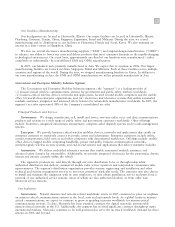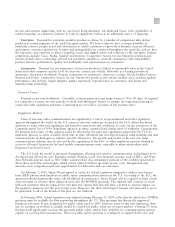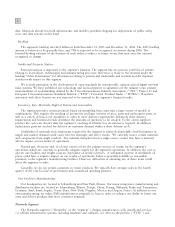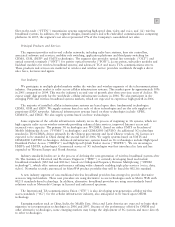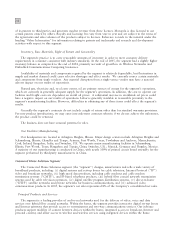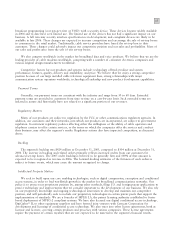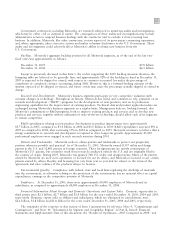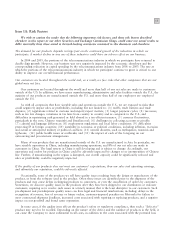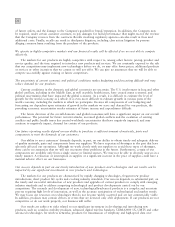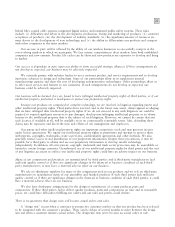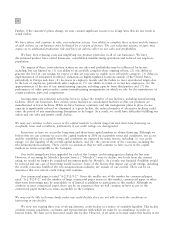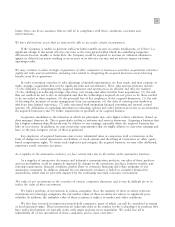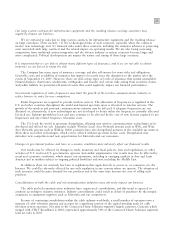Motorola 2005 Annual Report Download - page 22
Download and view the complete annual report
Please find page 22 of the 2005 Motorola annual report below. You can navigate through the pages in the report by either clicking on the pages listed below, or by using the keyword search tool below to find specific information within the annual report.
15
broadcast programming (not pay-per-view or VOD) with a security device. These devices became widely available
in 2004 and to date have seen limited use. The limited use of the devices has not had a significant impact on our
business. A full two-way security interface specification is in development, and compliant devices are likely to be
available in late 2006. These changes are expected to increase competition and encourage the sale of set-top boxes
to consumers in the retail market. Traditionally, cable service providers have leased the set-top box to their
customers. These changes could adversely impact our competitive position and our sales and profitability. Most of
our sales and profits arise from the sale of our set-top boxes.
We also compete worldwide in the market for broadband data and voice products. We believe that we are the
leading provider of cable modems worldwide, competing with a number of consumer electronic companies and
various original design manufacturers worldwide.
Competitive factors for our products and systems include: technology offered; product and system
performance, features, quality, delivery and availability; and price. We believe that we enjoy a strong competitive
position because of our large installed cable television equipment base, strong relationships with major
communication system operators worldwide, technological leadership and new product development capabilities.
Payment Terms
Generally, our payment terms are consistent with the industry and range from 30 to 60 days. Extended
payment terms are provided to customers from time to time on a case-by-case basis. Such extended terms are
isolated in nature and historically have not related to a significant portion of our revenues.
Regulatory Matters
Many of our products are subject to regulation by the FCC or other communications regulatory agencies. In
addition, our customers and their networks, into which our products are incorporated, are subject to government
regulation. Government regulatory policies affecting either the willingness or the ability of cable operators and
telephone carriers to offer certain services, or the terms on which the companies offer the services and conduct
their business, may affect the segment's results. Regulatory actions also have impacted competition, as discussed
above.
Backlog
The segment's backlog was $424 million at December 31, 2005, compared to $304 million at December 31,
2004. The increase in backlog and related orders primarily reflects increased orders from our customers for
advanced set-top boxes. The 2005 order backlog is believed to be generally firm and 100% of that amount is
expected to be recognized as revenue in 2006. The forward-looking estimates of the firmness of such orders is
subject to future events, which may cause the amount recognized to change.
Intellectual Property Matters
We seek to build upon our core enabling technologies, such as digital compression, encryption and conditional
access systems, in order to lead worldwide growth in the market for broadband communications networks. Our
policy is to protect our proprietary position by, among other methods, filing U.S. and foreign patent applications to
protect technology and improvements that we consider important to the development of our business. We also rely
on our proprietary knowledge and ongoing technological innovation to develop and maintain our competitive
position, and will periodically seek to include our proprietary technologies in certain patent pools that support the
implementation of standards. We are a founder of MPEG LA, the patent licensing authority established to foster
broad deployment of MPEG-2 compliant systems. We have also licensed our digital conditional access technology,
DigiCipher» II, to other equipment suppliers and have formed joint ventures with Comcast Corporation for
development and licensing of conditional access technology. We also enter into other license agreements, both as
licensor and licensee, covering certain products and processes with various companies. These license agreements
require the payment of certain royalties that are not expected to be material to the segment's financial results.


